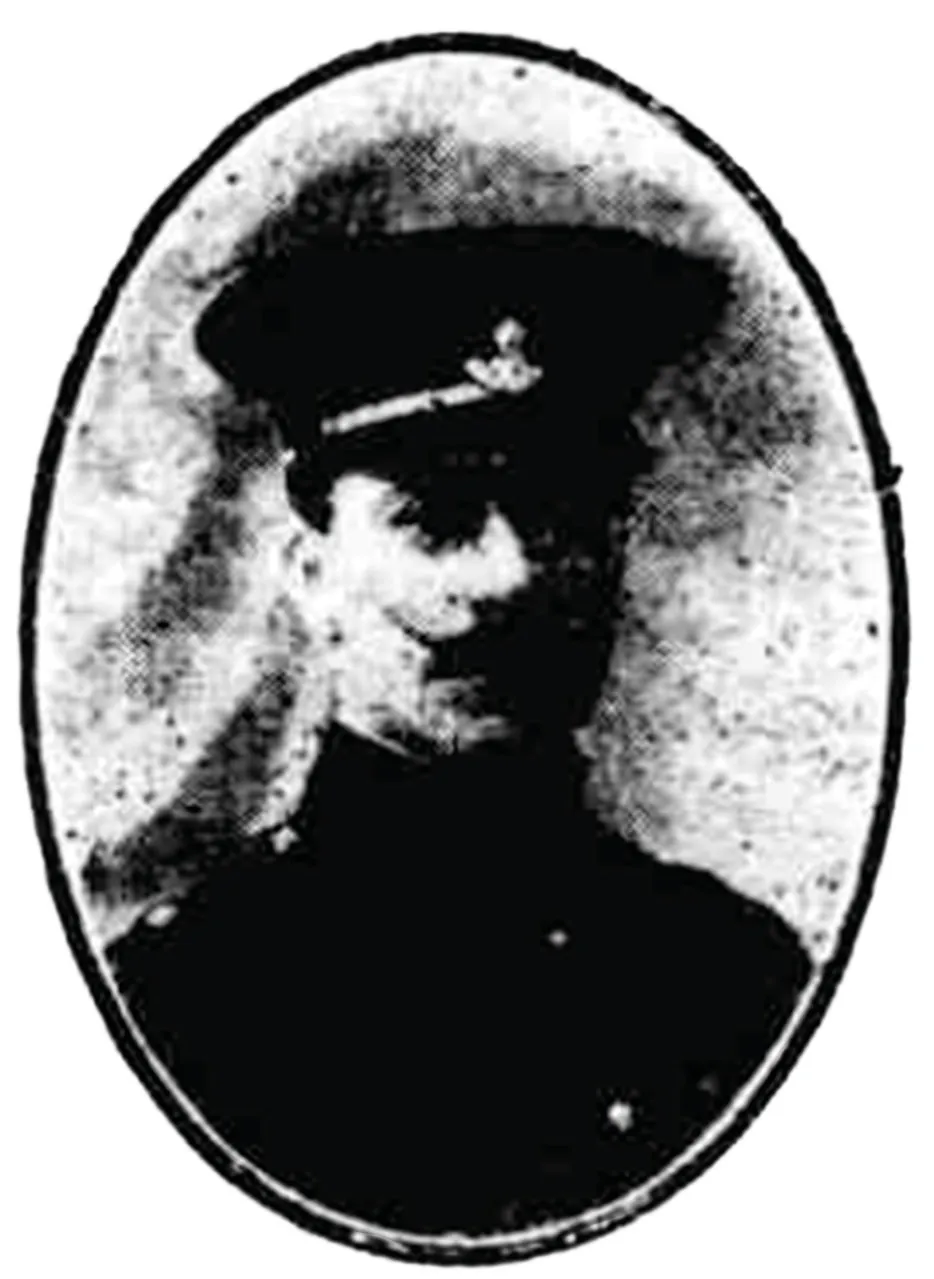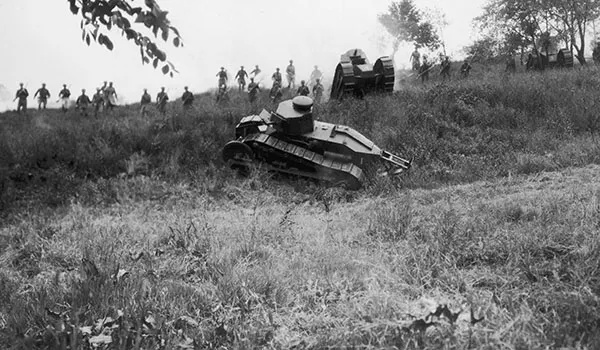Men, women and children thronged the streets of Walsall on 24 March 1918, to see the Mark IV tank Julian trundle through the market town. This battle-scarred wonder weapon had struck terror into German forces on the Western Front, and spectators were keen to witness its might and manoeuvrability for themselves.
Dignitaries gathered as the military band heralded Julian’s arrival. The event was part of the ‘tank bank’, a nationwide tour to raise funds for the war effort through the sale of war bonds and savings certificates. Children queued up to donate pennies, and towns competed to raise the most money. Over £2 million was donated – a vast sum for the time.
Driving the tank in Walsall that day was retired teacher David Stokes’ relation George Harrington, a decorated war hero whose valour could have been forgotten had it not been for David’s enthusiasm for genealogy.
“George is my first cousin once removed on my father’s side,” David explains. “I knew a lot about Mum’s family, thanks to the research of Sue Bentley, the wife of my cousin Roy on my mother’s side. My dad Sidney was a reticent man, and what I knew of his extended family could be summed up in five sentences. It was like shining a light into darkness.
“I was born in Walsall, West Midlands, and the trail there led to my great grandfather James Stokes, a remarkable man who started out as a blacksmith. He set up a buckle-making business, ran two pubs, and bought a large amount of property.”
In 1848, James married Sydonia Gnosill and they had 11 children, including David’s grandfather Frank Stokes and his great aunt Paulina. In 1878, Paulina married George Harrington and a year later they had a son, also named George – our future tank hero.
David discovered that George had a difficult start in life. “In 1892, Paulina died of a heart condition at the age of 40. For the previous decade, she had lived with her parents James and Sydonia at the Crown and Malt Shovel pub in Walsall. Paulina and George senior had separated when George was an infant,
and he had been brought up at the pub. Effectively, he was an orphan.”
In 2019, David began researching James Stokes using the collection of old newspapers on Findmypast. “What I discovered was totally unexpected and amazing.”
The 12 December 1914 issue of the Walsall Observer mentioned James’ name, but he wasn’t the main subject of the article. The headline read, “Recommended for DCM: Sergt-Major Twice Mentioned in Despatches.”
“There was a small photograph of a man in uniform, with dark hair and sporting a wide moustache. It was George Harrington – James’ grandson, Paulina’s son and my father’s cousin.

“The article explained that George had returned from the Western Front after being wounded in the foot. He was a regular soldier in the Durham Light Infantry, and had served ‘sixteen years in the colours’.
“I’m a real First World War buff, and have been on four tours of the battlefields with my pupils. This was before I discovered George. To find out that there was a war hero in our family was a total surprise.
“A friend of mine, Edward Wild, is very interested in the First World War and the Durham Light Infantry. Edward mentioned that George’s war record might be online, so I had a look on Findmypast. There it was, many pages of records covering George’s 21-year career as a soldier. I was astonished.”
George joined up in 1899 when he was 20 years old. That year the Second Boer War broke out and George was sent to South Africa, where he saw action over three years and suffered a leg injury. He was mentioned in dispatches for bravery and awarded the Queen’s South Africa Medal.
His battalion spent a year in India before returning to Britain, where George attended courses, gained certificates and was swiftly promoted to sergeant.
However, it wasn’t all plain sailing. “George and the peacetime Army didn’t know what to make of each other,” David reveals. “A remarkable war record from October 1913 reads ‘Quick-witted. Rose to rank of Colour Sergeant, but did not prove himself equal to the responsibilities of that rank. Unreliable.’
“Another document states that in 1913 he was court-martialled for drunkenness. It’s amazing to reflect that these damning words were written less than a year before his remarkable feats of bravery on the Western Front.
“Searching through George’s war record, I discovered that the newspaper report I had read was right. In 1915, he had been awarded the Distinguished Conduct Medal, or DCM. The citation was ‘for conspicuous gallantry on September 20, 1914, at Troyon, valley of the Aisne, in voluntarily rescuing wounded men under heavy fire. The following morning, he went out to the enemy trenches at dawn and brought back information of great value to our artillery.’ ”
George survived this mission by hiding beside the bodies of dead men, some of which had been there for three weeks.
“It’s hard to imagine the danger of George’s mission at Troyon, or to describe his bravery. I was so proud to read that he had received a DCM, which is second only to the Victoria Cross when it comes to military decorations.”
In July 1915, George’s battalion was posted to Hooge, in the Ypres Salient. By this time he had been reinstated as a sergeant-major. A hellish battle raged around an old château at Hooge where the German forces deployed flame-throwers for the first time. According to a report in the Walsall Observer, George “distinguished himself by special work” during the attack, although it cost him dearly.
“He had 15 pieces of shell removed from his head after Hooge, and was quoted as saying that there were still some very small bits left. He knew he was lucky to be alive.”
George spent most of 1916 in Britain where he must have undertaken training. He returned to the Front as a driver in the newly formed Tank Corps.

“In July 1917, the company was in the Ypres Salient, preparing for the Battle of Passchendaele. As usual, George was at the forefront of the action.”
Tanks had proved successful in previous battles, but they remained unreliable and were liable to break down. George’s tank soon ran into problems.
A newspaper report stated that “although wounded in head and leg, he [George] assisted while under fire in fixing the unditching gear, and carried on with his duties with great coolness and energy. Although in considerable pain, he volunteered for all work and kept up the spirits of his crew.” Following Passchendaele, he was awarded the Military Medal, which recognised acts of gallantry in battle on land.
Discovering such a wealth of detail has helped David to build a picture of George the man. “Coolness under fire, volunteering for dangerous tasks, leading from the front – these were the qualities he displayed as a sergeant-major. He risked his life time after time.
“George was a regular, an ‘old sweat’ who was a veteran of armed combat. Men like him made up the heart of the British Army, and they were vital in leading inexperienced young officers and soldiers. He seemed to thrive on the intensity of war, and it brought out the best in him.”
In November 1917, George returned to Britain with comrades from the Tank Corps to join the propaganda drive. The Tank Weeks were fêted occasions, and the crowds were entertained by acrobats, marching bands and sporting events. The vehicles would demonstrate their powers by driving over obstacles created for the occasion.
“George must have been so proud to drive Julian before the excited crowds in his home town of Walsall. Their arrival was described in the Walsall Observer. ‘Out sprang the crew – Sgt Harrington and two men… grimy and perspiring, and no doubt glad to escape from the hot and foetid atmosphere of Julian’s bowels.’ Pride of place was given to ‘gallant Sgt Harrington’.”
George left the British Army in 1920, and his references spoke a very different language to that of 1913. He was “of very good character. Performed very meritorious service. Highly spoken of for his work as RSM” (regimental sergeant-major).
“George’s life becomes misty after the war, although he worked as a ‘pensioner recruiter’ for the Army and applied to join the St John Ambulance in 1939. He died of tuberculosis in 1941 at Walsall Manor Hospital, where I was born seven years later. His uncle Charlie Stokes was with him when he died.
“It’s a pity that no one in the family knew of George’s bravery, and that there is no memorial to him in Walsall. I hope that will change one day. However, when I consider Company Sergeant-Major George Harrington DCM, MM, the most important thing to say is that his mother would have been proud of him.”
Do you have a family story to share with Who Do You Think You Are? Magazine? Email wdytyaeditorial@ourmedia.co.uk for your chance to appear in the magazine!




